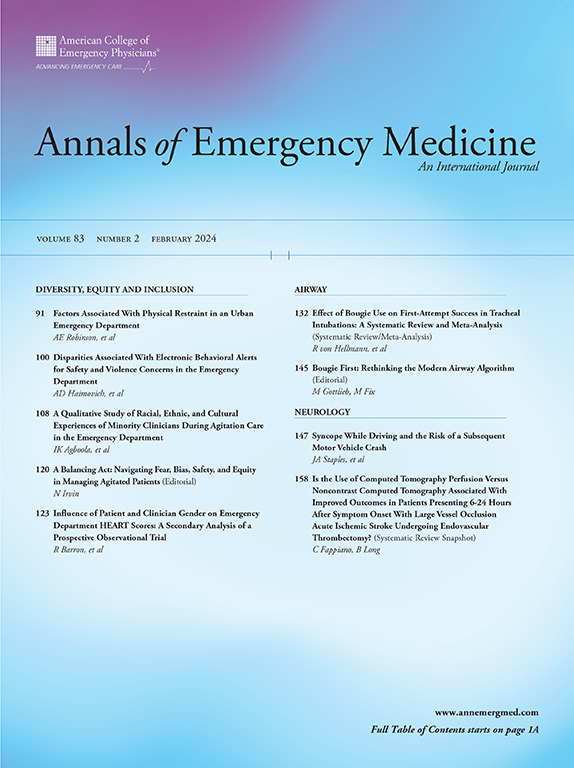冷却自来水作为烧伤的急救方法。
IF 5
1区 医学
Q1 EMERGENCY MEDICINE
引用次数: 0
摘要
研究目的在烧伤后3小时内应用20分钟的冷水可显著改善患者烧伤相关的预后。为了促进20分钟冷却自来水融入美国的临床实践,本调查旨在确定在院外紧急医疗服务(EMS)和院内急诊科(EDs)实施20分钟冷却自来水的障碍和促进因素,并共同设计其在急性烧伤急救中的常规使用策略。方法采用顺序混合方法设计,我们确定了20分钟冷水实施的障碍和促进因素,并共同设计了加强其实施的策略。EMS和ED临床医生完成了一份在线问卷,评估感知到的障碍和促进因素,并使用实施研究统一框架对回答进行了编码。与方便的参与者样本的半结构化访谈进一步检查了决定因素和共同设计的实施策略。结果共有371名临床医生(EMS 210名,ED 161名)参与问卷调查,22名临床医生(EMS 14名,ED 8名)参与访谈。在4个实施综合框架研究领域中确定了12个关键决定因素。实施障碍包括缺乏资源、将20分钟的冷却自来水适应当地临床环境的挑战,以及缺乏包括烧伤急救冷却的外部政策,而促进因素包括临床医生的积极性高、强大的专业网络和支持性的临床文化。共同设计的提高20分钟冷却自来水吸收率的策略包括便携式灌溉设备、护理驱动的协议和政策更新。尽管临床医生似乎有动力实施20分钟的冷却自来水,但基础设施、工作流程和政策方面的挑战阻碍了广泛采用。通过有针对性的共同设计的20分钟冷却自来水实施策略来解决这些障碍,将有助于整合到EMS和ED设置中,改善烧伤护理结果。本文章由计算机程序翻译,如有差异,请以英文原文为准。
Cool Running Water as a First Aid Treatment for Burn Injuries.
STUDY OBJECTIVE
The application of 20 minutes of cool running water within 3 hours of a burn injury significantly improves patient burn-related outcomes. To facilitate the integration of 20 minutes of cool running water into clinical practice in the United States, this investigation aimed to determine barriers and facilitators to implementing 20 minutes of cool running water in out-of-hospital emergency medical services (EMS) and in-hospital emergency departments (EDs) and to codesign tailored strategies for its routine use in acute burn first aid.
METHODS
Using a sequential mixed-methods design, we identified barriers and facilitators to 20 minutes of cool running water implementation and codesigned strategies to enhance its implementation. EMS and ED clinicians completed an online questionnaire assessing perceived barriers and facilitators, with responses coded using the Consolidated Framework for Implementation Research. Semistructured interviews with a convenience sample of participants further examined determinants and codesigned implementation strategies.
RESULTS
A total of 371 (210 EMS, 161 ED) clinicians participated in the questionnaire, and 22 (14 EMS, 8 ED) participated in interviews. Twelve key determinants were identified across 4 Consolidated Framework for Implementation Research domains. Implementation barriers included a lack of resources, challenges adapting 20 minutes of cool running water to local clinical settings, and the absence of external policies incorporating burn first aid cooling, whereas facilitators included high clinician motivation, strong professional networks, and a supportive clinical culture. Codesigned strategies to enhance 20 minutes of cool running water uptake included portable irrigation equipment, nursing-driven protocols, and policy updates.
CONCLUSION
Although clinicians appear motivated to implement 20 minutes of cool running water, infrastructure, workflow, and policy challenges hinder widespread adoption. Addressing these barriers through targeted codesigned 20 minutes of cool running water implementation strategies will facilitate integration into EMS and ED settings, improving burn care outcomes.
求助全文
通过发布文献求助,成功后即可免费获取论文全文。
去求助
来源期刊

Annals of emergency medicine
医学-急救医学
CiteScore
8.30
自引率
4.80%
发文量
819
审稿时长
20 days
期刊介绍:
Annals of Emergency Medicine, the official journal of the American College of Emergency Physicians, is an international, peer-reviewed journal dedicated to improving the quality of care by publishing the highest quality science for emergency medicine and related medical specialties. Annals publishes original research, clinical reports, opinion, and educational information related to the practice, teaching, and research of emergency medicine. In addition to general emergency medicine topics, Annals regularly publishes articles on out-of-hospital emergency medical services, pediatric emergency medicine, injury and disease prevention, health policy and ethics, disaster management, toxicology, and related topics.
 求助内容:
求助内容: 应助结果提醒方式:
应助结果提醒方式:


